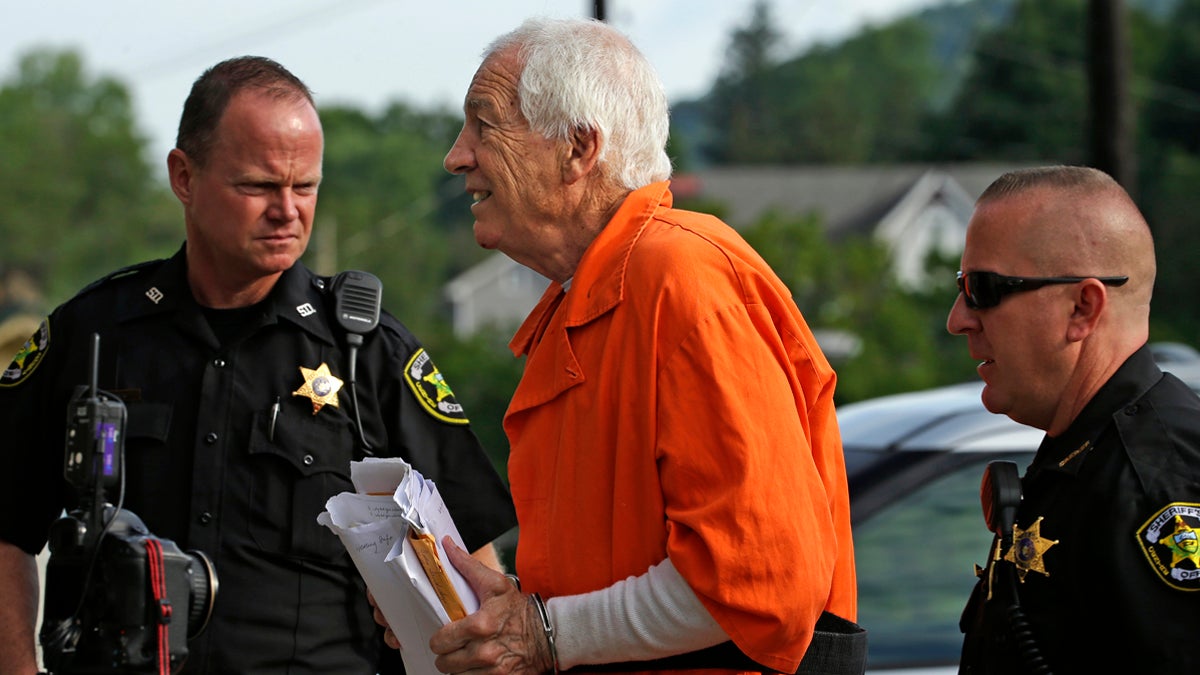Anti-child abuse laws overburdening Pennsylvania Child and Youth agencies

In this file photo, former Penn State University assistant football coach Jerry Sandusky, center, arrives at the Centre County Courthouse, in Bellefonte, Pa. Friday, Aug. 12, 2016. (Gene J. Puskar/AP Photo, file)
Twenty-four new laws were passed at the end of 2014, but no additional funding was provided.
This week, former Penn State University president Graham Spanier is in court for his role in the Jerry Sandusky child sex abuse scandal. This trial is one of the final chapters in a legal saga that has stretched since Sandusky was arrested in 2011.
But outside the courtroom, the effects of Sandusky’s actions are still being felt statewide.
In 2014, the state legislature passed 24 laws aimed at preventing something similar from happening again in Pennsylvania.
These laws widened the requirements for who is required to report suspicions of child abuse, increased penalties for those who don’t report, and required background checks for anyone who works with children.
If the goal was encouraging more people to report child abuse, the laws worked: The Department of Human Services saw a 62 percent increase in child abuse reports from January 2014 to January 2015. Every county (other than Juniata) had an increased number of child abuse cases reported. The background checks identified more than 1,800 people with sexual abuse records who were applying for jobs working with children.
Great news, right?
Yes … and no.
The Auditor General announced last week that he will be looking into the impact the additional laws have had on these agencies — and not for the better.
“There is no question in my mind that the legislation following the Sandusky revelations added extra burdens onto many of these agencies and the Department of Human Services,” said Auditor General Eugene DePasquale. “The challenge was, did the funding ever follow the additional requirements?”
DHS and the county-level Children and Youth agencies were not given additional state funds to accommodate these changes. Both entities have been crippled by the increased workload and lack of funding, according to state audits.
“Everyone was prepared for an explosion of reports coming from this legislation,” said Brian Bornman, executive director of Pennsylvania Children and Youth Administrators. “More reporters, a wider definition of child abuse, all of that was going to lead to more reports.”
Bornman says the agencies receive funding allocations two years in advance and have to prove a “trend” of change over at least three years before they can request supplemental funds. Since the changes went into effect all at once, multi-year trends are only beginning to show now.
“Counties were seeing a 30 to 120 percent increase in the amount of work their investigation units were performing, but there wasn’t much interest [from legislators] in a supplemental budget,” said Bornman. “Now that we’ve been documenting that for a few years, these agencies are just now going to be able to bring people on to accommodate that workload.”
Governor Tom Wolf’s budget includes a $44 million increase in funding for Children and Youth agencies, but that’s still $27 million short of what they’d need to be at full capacity. And some of the damage has already been done: Caseworker turnover is as high as 80 percent in some counties, says Bornman, and some county agencies are on provisional licenses because they can’t provide adequate services.
Naming the problem
The Auditor General has been auditing individual counties Child and Youth agencies, but decided to do a special report after an audit of ChildLine. The 2016 audit revealed that the child abuse hotline didn’t answer 42,000 calls in 2015, almost a quarter of all calls.
“That prompted me to go back to my team and say, ‘we have to double down on our efforts with Child and Youth Services audits,'” said DePasquale. “As we were going through those with a fine-toothed comb, a lot of these same issues were cropping up.”
County after county was reporting high staff turnover, high caseloads, and overburdened systems. The impact was tangible: missed calls, missed cases, and slow response time. DePasquale selected 13 — a mix of urban and rural demographics — to investigate further. That report is due out this fall.
While DePasquale won’t speculate yet on what the takeaways will be for the agencies, he said, “I would be stunned at the end of the day, when we come out with the report, that funding isn’t going to be part of the problem. But I’d also be stunned to say it’s all about funding as well.”
Bornman is pleased that DePasquale is getting involved — particularly if it means more funding will be provided to the agencies.
Sometimes, he says, it takes “someone from the outside taking a look at things and saying, ‘if you want this to be effective, you really have to go about it a different way.'”
“You can’t just pass laws and say, years later, maybe you’ll get the money, maybe you won’t.”
WHYY is your source for fact-based, in-depth journalism and information. As a nonprofit organization, we rely on financial support from readers like you. Please give today.


